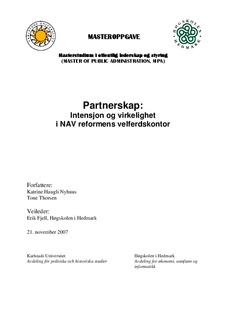Partnerskap : intensjon og virkelighet i NAV reformens velferdskontor
Abstract
The new Welfare Reform in Norway consists of the establishment of a new welfare office; NAV office. The NAV office will open in all municipalities within 2010 as local partnerships between the state and the municipals as equal partners. The central government will keep responsibility for the national services and the local governments will keep responsibility for the locally provided welfare services. As such the NAV office will consist of two separate public servcelines, with the accountabilities for their individual services intact. The Government wished to keep the separation between the national and local governmental services but needed to ensure the provision of a more holistic, integrated and effective service delivery, more in tune with the public need. The aim was to provide a more joined-up welfare service and to put more effect behind the efforts to achieve the reform goals: increased work participation, more user-friendly services and more effective public administration. The NAV office as such becomes a local one-stop-shop.
The challenge of this partnership is that two separate, traditionally hierarchic public structures embark on a partnership venture where the more relational and both vertical and horizontal communicational skills are required, true to the spirit of the joined-up government model. Our aim with this study was to investigate how a few early onset NAV offices cope with this partnership stunt. We particularly wished to examine how the partners establish and use the important vertical and horizontal dimensions, and how the partnership manager operate to facilitate the partnership activities.
We mean that the focus of 4 partnership actors rather than two governmental partners is more correct with respect to depicting the situation in the local NAV partnerships and how the central partnership managerial duties are shared. We have developed a new model of how they divide the partnership responsibilities between them and the operations of an emergent essential partnership driving force. We have also due to the nature of the NAV partnership actors and the way they operate in the partnership, developed a new partnership model. This dialogue model is a more accurate picture of the NAV partnership than the original partnership model.
The early attempts to provide integrated services has not reached the potential we have hoped for, partially due to the allowance of the two partners to continue service production in the old way while the reform structure and following administrative challenges are ironed out. We believe that an understanding of the particularities of partnership management and the adherence of the relational qualities to the partnership structure is a prerequisite in successfully managing the NAV partnership and thus the reform goals. This needs to be the imminent focus of the reform participants.
Description
Masteroppgaven ble presentert 6. desember 2007
